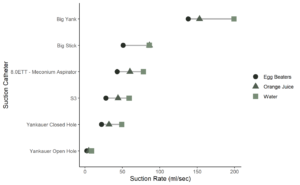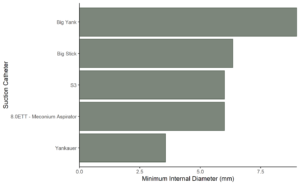Parham Salehi Saee1, MS4; Dhimitri A Nikolla, DO2
Affiliations:
1Lake Erie College of Osteopathic Medicine, Erie, PA.
2Department of Emergency Medicine, Saint Vincent Hospital, Allegheny Health Network, Erie, PA.
Introduction
Usually, blood or vomit in the oropharynx, a soiled airway can obscure relevant anatomy during laryngoscopy and make endotracheal intubation (ETI) more difficult. It has also been associated with reduced first pass success during emergency department ETI.1 Therefore, effective airway suctioning helps clear soiled airways and facilitates ETI.
Airway suctioning is usually performed with the Yankauer during emergent ETI. Although readily available, the Yankauer has poor suction rates compared to large-bore suction catheters.2-4 This paper summarizes recent studies comparing large-bore suction catheters to the Yankauer and reviews a couple of common airway decontamination techniques used during ETI of soiled airways.
Limitations of the Yankauer Compared to Large Bore Catheters
The Yankauer has a few disadvantages compared to large-bore suction catheters. The Yankauer has lower suction rates than large-bore suction catheters (Figure 1).2-5 These lower suction rates are likely due to the Yankauer’s small internal diameter compared to large-bore catheters (Figure 2).2-5 Even make-shift large-bore suction catheters, fashioned by connecting an endotracheal tube (ETT) to a meconium aspirator, had faster suction rates than the Yankauer.3-5 Second, the Yankauer may occlude more easily than large-bore catheters.4 Lastly, many Yankauer catheters have vent holes which will impair suction rates if unintentionally left open.2, 6
Figure 1 compares the suction rates of various suction catheters.2, 3 8.0ETT, 8.0mm endotracheal tube. (Click illustration to enlarge)
Figure 2 compares the minimum internal diameters of various suction catheters.2, 3 8.0ETT, 8.0mm endotracheal tube. (Click illustration to enlarge)
Techniques to Decontaminate Soiled Airways During ETI.
Two approaches to airway decontamination during ETI are suction-assisted laryngoscopy and airway decontamination (SALAD) and intentional esophageal intubation. SALAD technique involves initial suctioning of the oropharynx followed by laryngoscopy with continuous suctioning.7-10 In contrast, intentional esophageal intubation involves blindly placing an endotracheal tube into the esophagus and occluding the esophagus, which facilitates oropharyngeal suctioning and laryngoscopy.8
Conclusion
Large bore suction catheters have higher suction rates than the Yankauer suction catheter.2-5 SALAD technique and intentional esophageal intubation may facilitate decontamination and ETI of the soiled airway.8, 10 However, literature on suction catheter efficacy and decontamination techniques is limited to experimental and simulation studies. Therefore, it is unknown if large-bore catheters and dedicated airway decontamination techniques improve clinical outcomes during emergent ETI of soiled airways.
References
- Sakles JC, Corn GJ, Hollinger P, Arcaris B, Patanwala AE, Mosier JM. The Impact of a Soiled Airway on Intubation Success in the Emergency Department When Using the GlideScope or the Direct Laryngoscope. Acad Emerg Med. May 2017;24(5):628-636. doi:10.1111/acem.13160
- Andreae M, Cox R, Shy B, Wong N, Strayer R. 319 Yankauer Outperformed by Alternative Suction Devices in Evacuation of Simulated Emesis. Ann Emerg Med. 2016;68(4):S123. doi:10.1016/j.annemergmed.2016.08.335
- Nikolla DA, King B, Heslin A, Carlson JN. Comparison of Suction Rates Between a Standard Yankauer, a Commercial Large-Bore Suction Device, and a Make-shift Large-Bore Suction Device. J Emerg Med. May 15 2021;doi:10.1016/j.jemermed.2021.02.028
- Kei J, Mebust DP. Comparing the Effectiveness of a Novel Suction Set-up Using an Adult Endotracheal Tube Connected to a Meconium Aspirator vs. a Traditional Yankauer Suction Instrument. J Emerg Med. Apr 2017;52(4):433-437. doi:10.1016/j.jemermed.2016.09.006
- Nikolla DA, Heslin A, King B, Carlson JN. Comparison of suction rates between a standard Yankauer and make-shift large bore suction catheters using a meconium aspirator and various sized endotracheal tubes. J Clin Anesth. Sep 2021;72:110262. doi:10.1016/j.jclinane.2021.110262
- Cox R, Andreae M, Shy B, DuCanto J, Strayer R. Yankauer suction catheters with “safety” vent holes may impair safety in emergent airway management. Am J Emerg Med. Nov 2017;35(11):1762-1763. doi:10.1016/j.ajem.2017.04.009
- DuCanto J, Serrano KD, Thompson RJ. Novel Airway Training Tool that Simulates Vomiting: Suction-Assisted Laryngoscopy Assisted Decontamination (SALAD) System. West J Emerg Med. Jan 2017;18(1):117-120. doi:10.5811/westjem.2016.9.30891
- Fiore MP, Marmer SL, Steuerwald MT, Thompson RJ, Galgon RE. Three Airway Management Techniques for Airway Decontamination in Massive Emesis: A Manikin Study. West J Emerg Med. Aug 6 2019;20(5):784-790. doi:10.5811/westjem.2019.6.42222
- Pilbery R, Teare MD. Soiled airway tracheal intubation and the effectiveness of decontamination by paramedics (SATIATED): a randomised controlled manikin study. Br Paramed J. Jun 1 2019;4(1):14-21. doi:10.29045/14784726.2019.06.4.1.14
- Root CW, Mitchell OJL, Brown R, et al. Suction Assisted Laryngoscopy and Airway Decontamination (SALAD): A technique for improved emergency airway management. Resusc Plus. Mar-Jun 2020;1-2:100005. doi:10.1016/j.resplu.2020.100005


